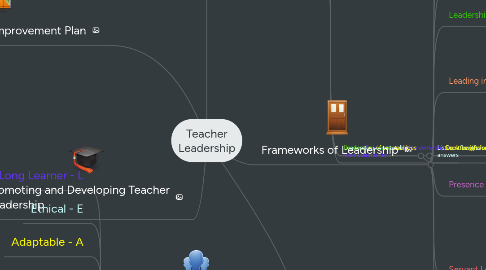
1. Personal Leadership Improvement Plan
1.1. My goal is to be open to leadership opportunities within my district and thoughtfully watch and learn from leaders around me who are inspirational and motivating, so that I may inherit quality techniques through my observations and practice.
1.2. I will improve on looking for the positives in situations where I would normally focus on the problems. I will become skilled in controlling my thought patterns so that I might encourage others.
1.3. I will seek mentorship from leaders who I desire to be more like.
1.4. I will seek opportunities to become actively engaged within my district's community.
2. Promoting and Developing Teacher Leadership
2.1. Factors that Promote Teacher Leadership
2.1.1. Administrative Assistance
2.1.2. Time for Collaboration
2.1.3. Committees
2.2. Factors that Inhibit Teacher Leadership
2.2.1. Administrative Control
2.2.2. Isolation
3. What is a Teacher Leader?
3.1. Life Long Learner - L
3.1.1. New node
3.1.1.1. New node
3.1.1.1.1. New node
3.2. Ethical - E
3.3. Adaptable - A
3.4. Dedicated - D
3.5. Empowering - E
3.6. Responsible - R
3.7. Strategic - S
4. Leadership and the Community
4.1. Leaders belong to and show ownership for their community
4.2. Leaders are accountable
4.2.1. Listen rather than defend, advocate or provide answers
4.3. Restoration of communities
4.3.1. Look for gifts and possibilities
4.3.2. Don't assign fear and fault
4.4. Restorative Justice
5. Frameworks of Leadership
5.1. Adapted Schools
5.1.1. All staff have a collective focus and values
5.1.2. Staff work in collaboration not isolation
5.2. Appreciative Inquiry
5.2.1. Searches for the best in people and organizations
5.2.2. Seeks to know what gives life to successful people and organizations
5.3. Frames
5.3.1. Frames and scenarios create understanding
5.3.2. Wording and language helps us understand frames
5.4. Leadership and the New Science
5.4.1. Simpler ways to lead organizations
5.4.2. Using the natural world order as a muse for leading organizations
5.5. Leading in a Culture of Change
5.5.1. Moral Purpose
5.5.2. Understanding Change
5.5.3. Relationship Building
5.5.4. Knowledge Creation and Sharing
5.5.5. Coherence Making
5.6. Presence
5.6.1. Seven Medatative Spaces
5.6.1.1. Awareness
5.6.1.1.1. Stopping
5.6.1.2. Calmness
5.6.1.2.1. Stillness
5.6.1.3. True Thinking
5.6.1.3.1. Attainment
5.6.2. The U Theory
5.6.2.1. Suspending
5.6.2.1.1. Redirecting
5.6.2.2. Letting Go
5.6.2.2.1. Letting Come
5.6.2.3. Prototyping
5.6.2.3.1. Institutionalizing
5.7. Servant Leadership
5.7.1. Listening
5.7.1.1. Empathy
5.7.1.1.1. Healing
5.7.2. Conceptualization
5.7.2.1. Foresight
5.7.2.1.1. Stewardship
5.7.3. Commitment to Growth of Commuity
5.7.3.1. Building Community
5.8. Systems Theory
5.8.1. All focus on goal of organization instead of individual needs/desires
5.8.2. Individual success is a part of the larger success of the organization
5.8.3. Shared Vision
5.8.4. Team Learning
